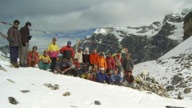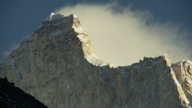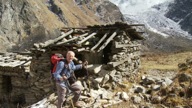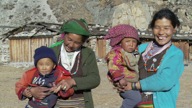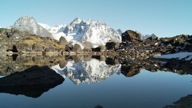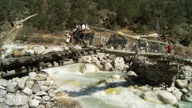Several years in the making, the project retraces Joseph Hooker’s ground breaking explorations in the Himalayas, the Antarctic, Morocco, the USA, Australia and New Zealand. Using Hooker’s notebooks and sketches from the Archives at the Royal Botanic Gardens at Kew UK, Peter is the first to go exactly where Hooker travelled in 1848, through the remote and rarely visited Kangchenjunga region of Eastern Nepal and on foot for hundreds of kilometres with winter approaching. This region is one of the most beautiful and wild regions on earth and is home to the world’s third highest mountain, roaring rivers, high semi desert, yaks, isolated villages and snow leopards. The expedition reaches the Tibetan border, unattended apart from the occasional yak caravan crossing from Tibet, and exactly as it was in Hooker’s day. Some areas have probably never been filmed before.
In the Steps of Sir Joseph Hooker
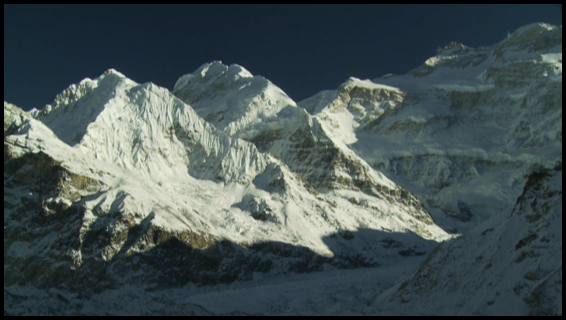
Kangchenjunga
The country has changed markedly in the past 160 years and much of it is due to a warming climate. Peter uses the beautiful rhododendrons that Hooker discovered to show how plants vary with altitude and he locates the precise spot at Nango Mountain which sealed Darwin’s argument for the world having been a colder place. This location was a crucial factor in Darwin being able to explain why arctic type plants are found on isolated mountain tops around the world and Peter explains the significance of the site.
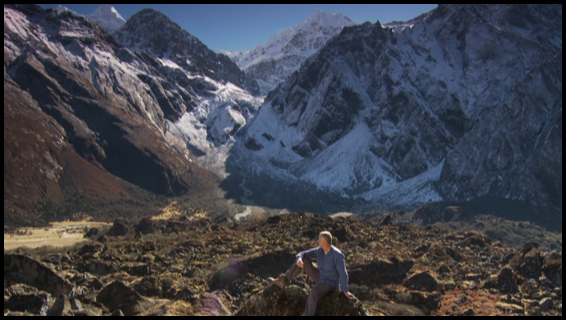
Nango Mtn
Climbing high into the mountains Peter discovers the extent to which the Nango glacier has receded as well as how devastating landslides have destroyed the livelihood of Yangma village. He visits the now deserted monastery of Nup and back home finds the first Western sketch of Mount Everest done by Joseph Hooker eight years before it was officially measured and named.
On a return visit to the Sikkimese Himalayas close to the monsoon period, Peter films Hooker’s rhododendrons in full bloom. Hooker painted detailed watercolour sketches of these plants and their flowers on site and these sketches were then used by the renowned botanical artist, Walter Fitch, for his lithographs in the magnificent “Rhododendrons of the Sikkim Himalaya” book. This book led to a worldwide craze for these wonderful plants. Peter visits the ruins of the Rajah of Sikkim’s palace in Tumlong where Joseph and Archibald Campbell were held captive after illegally crossing Sikkim into Tibet in defiance of the Rajah's orders. Their imprisonment resulted in 14000 British troops being sent from Calcutta to secure their release. The British punished the Rajah for his actions by appropriating parts of Sikkim and this led to the eventual weakening of the Himalayan kingdom and its forceful annexation by India.
Hooker sailed to the Auckland and Campbell Islands 700km south of New Zealand on board the Erebus, one of two ships of the Ross Antarctic Expedition of 1839-43. He was the youngest crew member and was botanist and Assistant Surgeon. The main aim of the voyage was to find the South Magnetic Pole and it was the last major voyage of exploration made entirely under sail. The Auckland and Campbell islands are some of the most oceanic environments on Earth and Peter shows the unique megaherbs that Hooker found as well as Hooker sea lions, rare yellow eyed penguins and royal albatrosses. On a wild windy cliff on Campbell Island Peter finds a tiny but significant daisy which is depicted on Hooker’s plaque at St Annes’ church at Kew, the site of Hooker's burial.
Hooker and Peter both nearly lost their lives at sea on their respective voyages to the Ross Sea and footage of rough seas and ice floes as well as Peter’s previous visit on the 18m yacht, Solo, the smallest vessel to visit mainland Antarctica, accompanies this section.
The videos illustrate how Hooker noticed the similarities between plants growing in widely separated areas in the Southern Hemisphere, and how he developed his theory that they were remnants of the flora of a great southern continent which we now know to be Gondwana. Using footage of southern beeches and tree ferns from Tasmania, New Zealand and South America as well as proteas, telopeas and banksias from South Africa and Australia, Peter illustrates these relationships. He also shows the incredible variety of plants from western Australia which led Hooker to believe that it is one of the oldest landscapes on earth, contrary to Darwin's view.
Peter retraces Joseph’s travels through Morocco, searching for cedars and other plant links around the world, and in the main square of Marrakech he discusses Hookers obstinacy in refusing to dismount for several hours while demanding a suitable palace be provided by the Sultan. This provides a clear window into his very strong personality. He visits the Caves of Hercules near Tangiers to show how Hooker’s analysis of ancient human excavations of mill stones indicate that this part of Africa had not sunk in recent geologic history.
Interspersed throughout the videos are interviews with eminent scientists discussing the great and continuing significance of Hooker as a botanist as well as his major contributions to the Theory of Evolution.



